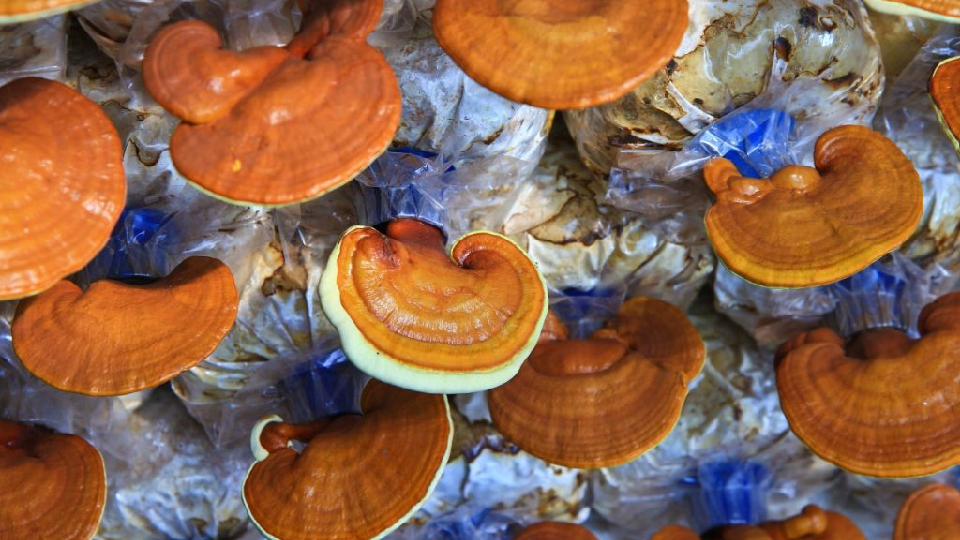Reishi Mushroom Growing: A Comprehensive Guide
Growing your own Reishi mushrooms can be fulfilling, and it is also a cost-effective way to enjoy the benefits of this superfood. Growing these mushrooms at home is not as difficult as it may seem. The process requires some patience and attention to detail, but with the right tools and knowledge, anyone can enjoy a successful harvest.
Studies have shown that Reishi mushrooms have multiple health benefits, such as reducing inflammation and boosting the immune system[1]. As a result, they have become a popular natural remedy for conditions like allergies, fatigue, skin problems, and digestive issues.
This guide offers a detailed overview of growing Reishi both indoors and outdoors. It covers the different stages of the growing process, the required tools and materials, and practical tips for achieving a successful harvest. With this information, you can cultivate your own Reishi mushrooms and enjoy their potential health benefits.
In this article:
What Are Reishi Mushrooms?
Reishi mushrooms, also known as Ganoderma lucidum, have a rich medicinal history in Traditional Chinese Medicine (TCM) and are native to various parts of Asia such as China, Japan, and Korea. Nowadays, they’re increasingly consumed as a dietary supplement[2].
Their distinctive appearance features a shiny, reddish-brown cap and a woody stem. Reishi mushrooms have a bitter taste and tough, woody texture. They earned the nickname “mushroom of immortality” due to their long history of use and claimed health benefits.
These mushrooms are thought to provide numerous health advantages, such as enhancing the immune system, reducing inflammation, and improving sleep. Their bioactive compounds, such as polysaccharides, triterpenes, and amino acids, are credited for these effects.
What Do Reishi Mushrooms Look Like?
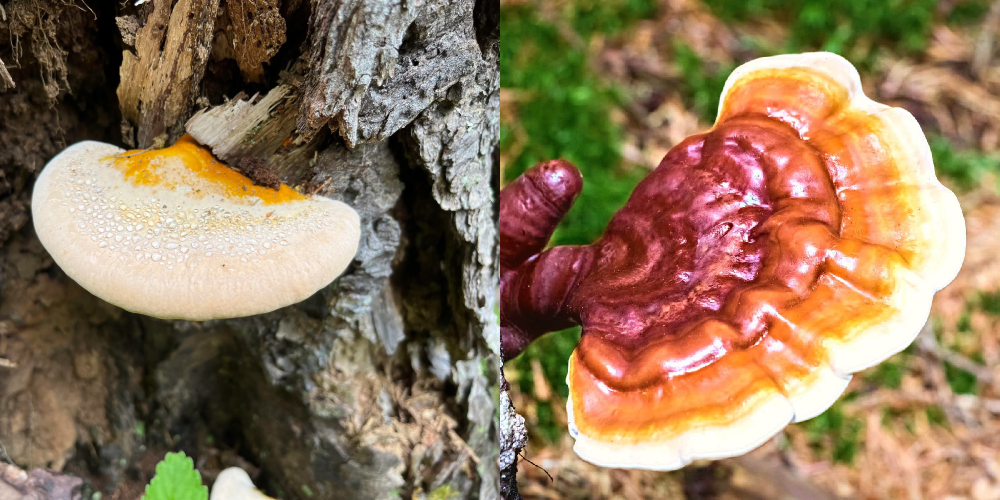
Did you know that the name ‘Ganoderma’ comes from Greek words that mean ‘bright’ or ‘shining skin’? This name makes sense because the tops of Reishi mushroom caps truly have a stunning, polished shine to them.
Imagine this: mature Reishi mushroom caps take on the shape of clam shells. When they’re young, they look like vibrant, colorful fingers until the cap starts forming. As they grow older, these caps reveal captivating rings of red, orange, and white hues. The exact colors can change based on the species and the environment they grow in[3].
And here’s something cool: Reishis aren’t like your typical mushroom with gills. They’re actually polypores. So, picture this – the bottom of the cap, where the spores come from, resembles a surface full of small dots, just like a sponge with tiny pores. Oh, and guess what? This pore surface is usually white, which adds to its unique appearance.
Paul Stamets
A renowned mycologist, describes reishi mushrooms as having a strong, earthy flavor that is bitter and slightly pungent, with a slightly sweet aftertaste.
Where Does Reishi Mushroom Grow?
Reishi mushrooms naturally grow in various regions throughout Asia, including China, Japan, and Korea, and can be found on decaying hardwood trees in forests with warm and humid climates. While they can grow on both living and dead trees, they are more commonly found on dead or dying trees in clusters of various sizes. However, they require specific growing conditions such as a warm and humid environment, shade, and decaying wood, making them difficult to cultivate and often harvested from the wild.
Recently, growing Reishi mushrooms at home has become more popular in Western countries, allowing for wider availability for medicinal and culinary use through cultivation on logs, sawdust, and other substrates that mimic their natural environment.
Why Growing Reishi Mushroom?
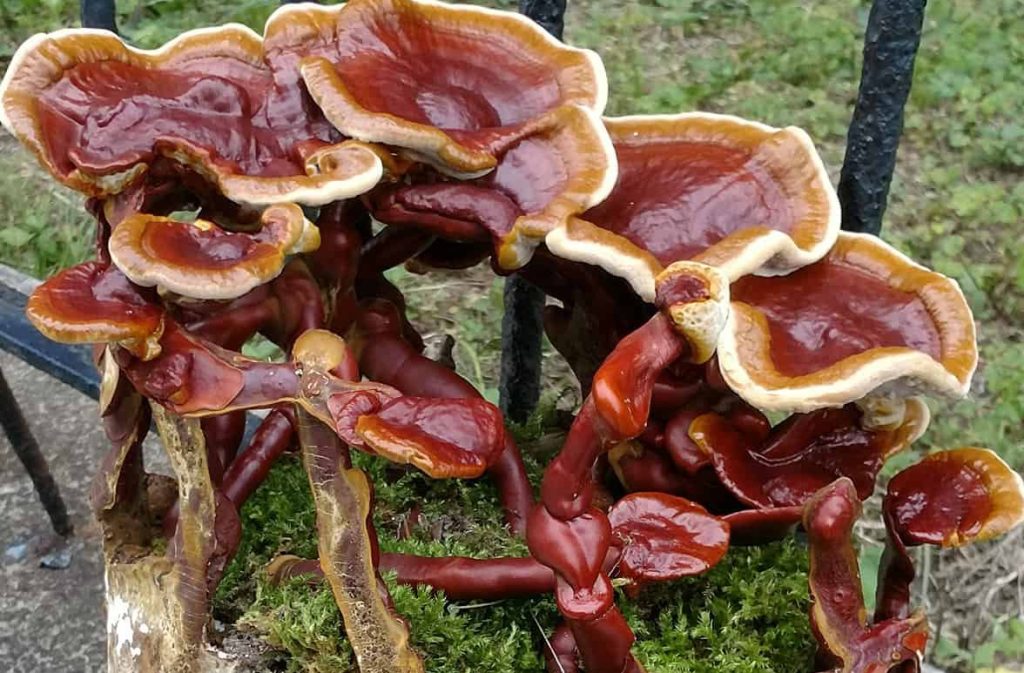
Reasons to Grow Reishi
1. Health benefits
Growing your own reishi mushrooms can provide you with access to fresh, high-quality mushrooms that are packed with nutrients and bioactive compounds. These compounds can help boost your immune system, reduce inflammation, and improve your overall health and well-being[4]. You can use the mushrooms in teas, tinctures, and other herbal remedies to maximize their benefits.
2. Cost-effective
Growing your own reishi mushrooms can be a cost-effective way to access this powerful medicinal food, rather than buying them from a health food store or herbalist, which can be expensive. To do so, you’ll need some basic equipment and a little bit of know-how. With these, you can grow your own supply of reishi mushrooms for a fraction of the cost of buying them.
3. Sustainability
Growing your own reishi mushrooms can contribute to sustainable agriculture and reduce your carbon footprint. This is because many commercially-grown mushrooms are produced in large-scale, industrial operations that have a considerable environmental impact.
4. Fun and educational
Growing your own Reishi mushrooms is a fun and educational hobby that can teach you about the fascinating world of fungi. Growing Reishi is also an environmentally friendly way to enjoy the many benefits of these superfoods, as it reduces the need for transportation and packaging.
4. Culinary uses
You can enjoy the delicious and unique flavor of reishi mushrooms by incorporating them into your cooking. These mushrooms have a slightly bitter, woody taste that complements savory dishes such as soups, stews, and stir-fries. Growing your own reishi mushrooms is a great way to have a fresh and flavorful supply for your culinary creations.
How to Grow Reishi Mushrooms Indoors
To grow Reishi mushrooms indoors, you can use a grow tent or a growing kit that lets you manage temperature, humidity, and airflow. This enables you to have greater control over the growing conditions, ensuring a regulated environment for optimal growth.
Dr. Paul Stamets, Mycologist
“Reishi is a mushroom that can be grown very easily in a home setting. With a little bit of effort and knowledge, one can grow a steady supply of Reishi mushrooms to use in teas, tinctures, and other medicinal preparations. Growing Reishi mushroom is a rewarding experience that can provide great health benefits.”
Whether you are a seasoned mushroom grower or just starting out, growing Reishi mushrooms indoors is a fascinating and rewarding experience that can yield a potent natural medicine[5].
In the following sections, we will provide detailed guidance to help you make the best decision based on your needs and resources. We will also provide step-by-step instructions to help you implement the chosen method.
Method 1: Growing Reishi Mushroom Using Grow Kit
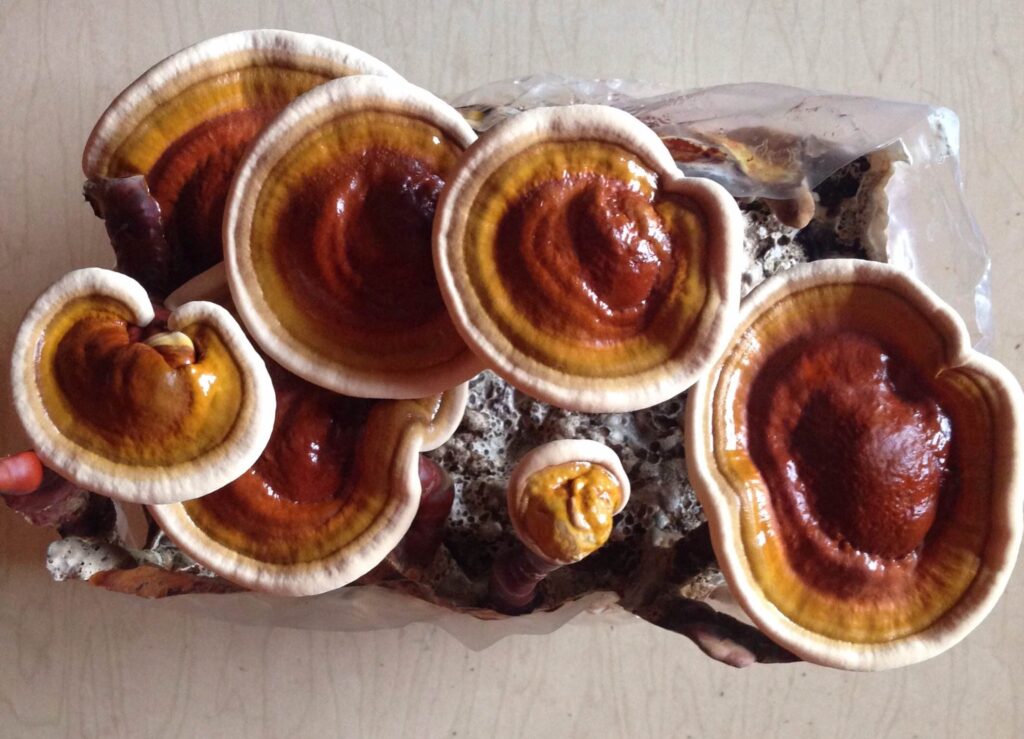
If you want to grow your own Reishi mushrooms, consider using a grow kit specially designed for the task. Ensure that the kit includes all the essential components like substrate, moisture, and temperature control. Also, look for a kit with step-by-step instructions and useful tips for successful mushroom cultivation.
With the right Reishi mushroom growing kit and some patience, you can soon have a constant supply of fresh, flavorful mushrooms to use in your favorite recipes or for medicinal purposes.
Materials needed:
- Reishi Mushroom Growing Kit
- A spray bottle – Paper towels
- A knife
- A medium-sized container
- Potting soil
Steps:
- Prepare the container by filling it with a mix of potting soil and perlite, making sure that it is mixed thoroughly.
- Carefully remove the growing kit from its packaging and place it in the container.
- Spray the grow kit with water using the spray bottle. Make sure to keep the kit moist, but not wet.
- Place a few paper towels over the top of the container, tucking them around the edges. This will keep the kit moist and help it to germinate.
- Place the container in a warm, dark location.
- Check the kit every day for signs of growth.
- Once you see the mushrooms appear, use a knife to carefully remove them from the kit.
- Place the harvested mushrooms in a paper bag and store them in the refrigerator for up to two weeks.
- The kit can be reused up to three times before needing to be replaced.
Method 2: Using Spawn
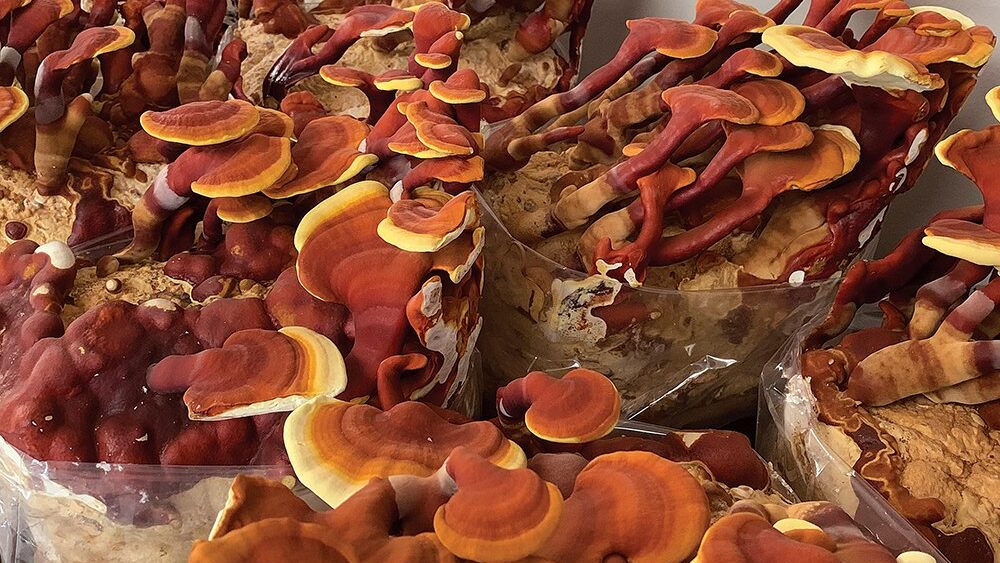
Growing Reishi mushrooms using spawn is an enjoyable and rewarding activity that provides you with fresh, high-quality mushrooms. To get started, choose the right spawn that suits the environment you plan to cultivate them. Spawn is ideal for indoor cultivation, and it’s essential to select the appropriate strain of Reishi mushroom for the best results.
Materials needed:
- Reishi spawn
- Peat moss
- Vermiculite
- Plastic container with lid
- Spray bottle
- Water
Steps:
- Soak the reishi spawn in water for 24 hours.
- Mix peat moss and vermiculite in a 3:1 ratio.
- Fill a plastic container with the mixture
- Spread the spawn evenly throughout the container
- Spray the top with water before placing the lid on.
- Place the container in a warm, dark location and keep it moist.
- Next, find a warm, dark location for the container and keep it moist.
- Mist the container with a spray bottle 1-2 times a day to maintain the proper moisture level.
- Allow the reishi mushrooms to grow for 8-12 weeks, until they are ready to be harvested.
Tips:
To achieve a successful Reishi mushroom harvest, it is crucial to begin with fresh and viable spawn. After filling the container with the appropriate mixture and spawn, place it in a warm and dark location while ensuring sufficient ventilation. Mist the container with a spray bottle 1-2 times daily to maintain the optimal moisture level.
How to Grow Reishi Mushrooms Outdoors
Growing reishi mushrooms outdoors is a great way to have a fresh supply of this valuable mushroom at home. Although they are typically grown indoors, these mushrooms can also be grown outdoors, especially in areas with cool and humid climates.
There are several methods for growing them outdoors, including log cultivation and sawdust cultivation. Both methods require some basic knowledge of mushroom cultivation and a bit of patience, but they are relatively easy to follow and can produce a bountiful harvest.
In the following sections, we will provide step-by-step instructions for each of these methods so you can choose the one that best fits your needs and resources.
Method 1: Growing Reishi Mushroom Using Log Cultivation
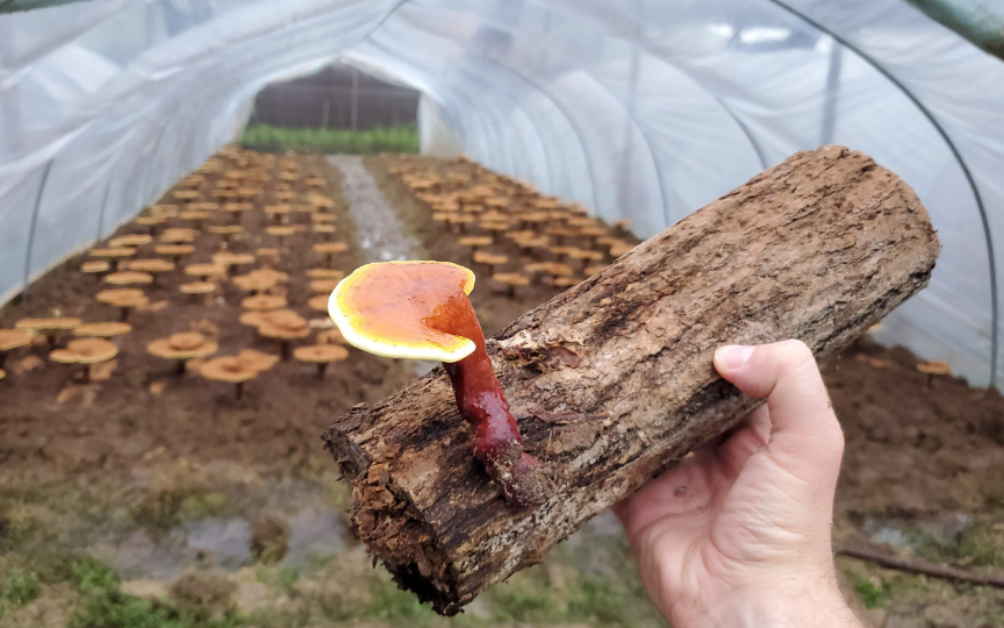
Growing reishi mushrooms outdoors on logs is a traditional method of cultivating this medicinal fungus. It involves inoculating logs with reishi mushroom spawn, which allows the mycelium to colonize the log and eventually produce fruiting bodies.
This method requires less equipment and is relatively low maintenance, making it an accessible option for home growers or small-scale farmers. Outdoor log cultivation can also yield a higher quantity of mushrooms compared to indoor methods.
Materials:
- Freshly cut hardwood logs (oak, maple, or similar)
- Reishi mushroom spawn
- Wax (such as beeswax or cheese wax)
- Drill with a 5/16-inch bit
- Hammer
- Silicone or latex sealant
Steps:
- Start by obtaining fresh hardwood logs. Oak, maple, and sweetgum are good choices. The logs should be around 4 to 6 inches in diameter and 3 to 4 feet in length.
- Next, drill holes in the logs using a 5/16-inch drill bit. The holes should be spaced about 4 inches apart and should be about 2 inches deep.
- Insert the Reishi mushroom spawn into the holes using a hammer. Tap the spawn into the holes gently, making sure it is flush with the log’s surface.
- Once all the holes have been filled with spawn, cover them with wax to seal them. This will help prevent contamination and moisture loss.
- Store the logs in a shaded and moist location, preferably under a tree canopy. Keep them off the ground by placing them on cinder blocks or other supports.
- After about 6 to 12 months, the Reishi mushrooms should start to appear on the logs. Harvest them by cutting them off at the base of the stem with a sharp knife.
- Repeat the process with new logs and spawn to continue your harvest.
Method 2: Using Sawdust Cultivation
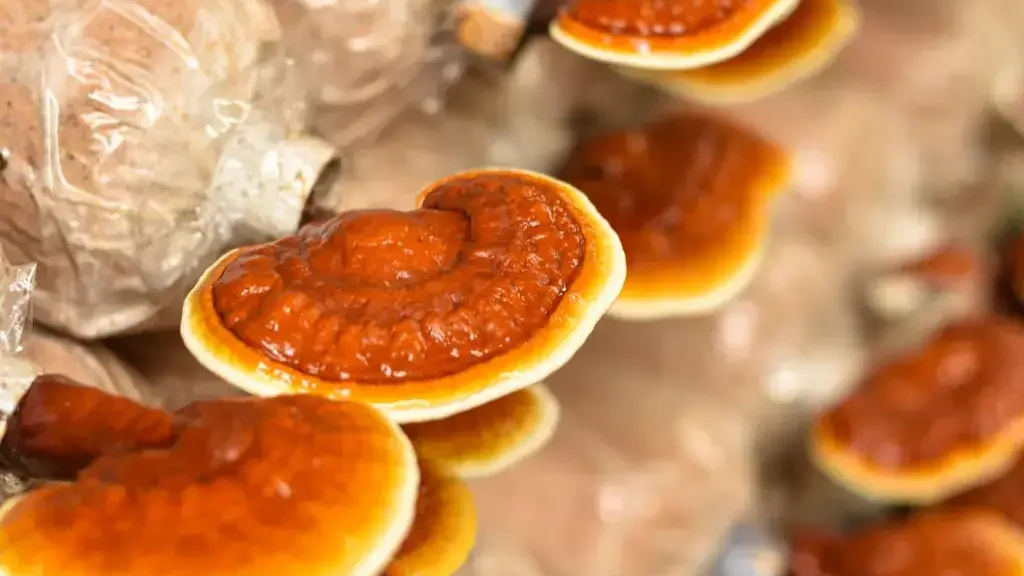
Growing reishi mushrooms on sawdust cultivation is a popular method for home cultivation. It involves using sawdust as a substrate to grow the mycelium of the reishi mushroom. Sawdust is readily available and relatively inexpensive, making it a great option for those who want to grow reishi mushrooms at home. This method also allows for greater control over the growing conditions, resulting in a higher yield of mushrooms.
Materials:
- Sawdust (preferably oak or maple)
- Reishi mushroom spawn
- Large sterilizable bags
- Gypsum powder
- Water
- Pressure cooker or large pot with lid
- Drill and 1/4-inch drill bit
- Hammer and nail
- Rubber bands
Steps:
- Prepare the sawdust by mixing it with water and gypsum powder until it has a moisture content of about 60-65%.
- Sterilize the sawdust mixture by placing it in a pressure cooker or large pot with a lid and boiling it for at least 1 hour.
- Allow the sawdust mixture to cool completely before adding the mushroom spawn.
- In a clean and sterile environment, break up the mushroom spawn and mix it into the sawdust mixture thoroughly.
- Prepare the bags by drilling several small holes on opposite sides near the top of each bag. These will be used for air exchange.
- Fill the bags with the sawdust and spawn mixture, leaving about 2-3 inches of space at the top.
- Seal the bags by folding the top over several times and securing it with rubber bands.
- Sterilize the bags by placing them in a pressure cooker or large pot with a lid and boiling them for at least 2-3 hours.
- Allow the bags to cool completely before inoculating them with spores.
- Inoculate the bags by making small holes in the top and injecting them with spores using a sterile syringe.
- Place the bags in a cool and dark location, such as a basement or garage, and allow them to incubate for 2-3 months.
- After 2-3 months, move the bags to a warmer and brighter location, such as a greenhouse or outdoor space with filtered sunlight.
- Spray the bags with water regularly to maintain moisture levels and wait for the mushrooms to begin fruiting.
- Harvest the mushrooms when they are fully grown and mature.
Cultivate Your Own Reishi Mushrooms – Tips
When to Plant Them?
To ensure optimal growth and yield, the timing of planting reishi mushrooms holds great importance. Selecting the appropriate season becomes crucial, considering their preference for cooler temperatures and thriving in moist environments. Here are additional details on the recommended planting periods:
For ideal growth, plant reishi mushrooms during spring or fall. In the northern hemisphere, this entails planting in April or May, or September or October. In the southern hemisphere, opt for October or November, or March or April.
Temperatures
While reishi mushrooms thrive between 60 and 80 degrees Fahrenheit, they can tolerate temperatures as low as 40 degrees and as high as 90 degrees.
High humidity levels ranging from 85% to 95% provide the best conditions for reishi mushroom growth. Inadequate humidity may cause insufficient development and drying. Ensuring full hydration of logs or chosen substrates before planting is essential. This guarantees the mushrooms have the necessary moisture for growth.
Growing Environment
You have options when it comes to growing reishi. Whether it’s in a greenhouse, on the forest floor, or in a DIY shaded and humid setup, the choice is yours. While setting up a greenhouse demands a bit more initial investment compared to outdoor setups, it’s worth noting that mushrooms tend to mature faster in a greenhouse.
When you’re using a greenhouse, make sure you cover it with 70% to 75% shade cloth. Remember, the amount of oxygen the mushrooms need will change based on the specific growth phase you’re in.
How Long does it Take to Grow a Reishi Mushroom?
Well, patience is essential since the process is gradual, yet the outcome proves worthwhile. The growth duration of Reishi mushrooms hinges upon cultivation methods and conditions. Typically, maturation requires 6-12 months, although full development may extend up to 2 years.
Various cultivation methods exist, such as sawdust, log, and indoor cultivation, each adhering to distinct timelines and prerequisites. Consistently monitoring and nurturing the growth of Reishi mushrooms is crucial. Temperature, humidity, and proper airflow are influential factors.
FAQs
Can You Grow Reishi Mushrooms at Home?
Yes, you can grow Reishi mushrooms at home. You’ll need Reishi spores or a kit. It’s a bit challenging and takes time. Follow instructions carefully. Keep the environment clean, and humid. Be patient, they’re slow growers.
Can Reishi Grow on Straw?
Reishi mushrooms primarily grow on hardwood logs or sawdust-based substrates. While they can grow on straw, it’s less common and might require more controlled conditions. Using hardwood is the preferred method for cultivating healthy Reishi mushrooms, but experimental growers can explore straw as an alternative substrate.
Is Reishi Easy to Grow?
No, Reishi mushrooms are not easy to grow. They can be a bit challenging to grow for beginners due to thier specific temperature and humidity requirements. However, with the right guidance and a controlled environment, it becomes more manageable. Experienced growers often find it easier. Patience and attention to detail are key to successful Reishi cultivation.
What Temperature Does Reishi Mushroom Grow?
Reishi mushrooms typically grow at temperatures between 75 to 85°F (24 to 29°C). They thrive in warm and humid conditions, making them suitable for cultivation in controlled environments. Maintaining this temperature range is essential for successful Reishi mushroom growth, whether you’re growing them indoors or outdoors.
Do Reishi Mushrooms Grow in the US?
Yes, Reishi mushrooms grow in the US. They can be found in different regions, especially in the eastern and western parts of the country. These mushrooms are known for their adaptability and have become a popular choice for cultivation by enthusiasts, making them accessible to those interested in growing them at home.
Does Reishi Only Grow on Trees?
No, Reishi mushrooms don’t only grow on trees. While they’re often found on tree trunks, they can also grow on logs and even underground roots. Their adaptability makes them more accessible for cultivation, not just in forests but also in controlled environments. So, Reishi can grow in various places.
Conclusion
Reishi mushroom is a unique and fascinating species of fungus that has been cultivated for centuries due to its medicinal properties. Its cultivation requires specialized techniques and knowledge, as well as suitable environmental conditions for optimal growth. As a result, the cultivation of Reishi mushrooms is a time-intensive and detailed process, but with the right knowledge and resources, it can be a rewarding experience.
The renowned mycologist, Paul Stamets once said:
“Mycelium is the neurological network of nature. Interlacing mosaics of mycelium infuse habitats with information-sharing membranes. These membranes are aware, react to change, and, most importantly, connect interdependently with the surrounding ecology and each other.”
With the right amount of care and effort, Reishi mushroom cultivation can be a fruitful endeavor for both amateur and experienced mycologists alike.
References
1. Effects of Ganoderma lucidum essence powder and Ganoderma Lucidum spore powder on immune function of mice with Lewis lung cancer. Retrieved from https://www.researchgate.net/publication/287101230_Effects_of_Ganoderma_lucidum_essence_powder_and_Ganoderma_Lucidum_spore_powder_on_immune_function_of_mice_with_Lewis_lung_cancer
2. Traditional Chinese Medicine, “Reishi Mushroom,” Retrieved from https://www.ncbi.nlm.nih.gov/books/NBK92757/
3. Cultivation Technology of the Fungus Ganoderma lucidum (Curtis) P. Karst. Retrieved from https://www.researchgate.net/publication/359317900_Cultivation_Technology_of_the_Fungus_Ganoderma_lucidum_Curtis_P_Karst
4. A brief overview of the potential health benefits of Ganoderma lucidum. Retrieved from https://www.researchgate.net/publication/348135206_A_brief_overview_of_the_potential_health_benefits_of_Ganoderma_lucidum
5. Pharmacological properties and use of Ganoderma lucidum in modern medicine. Retrieved from https://www.researchgate.net/publication/368961047_Pharmacological_properties_and_use_of_Ganoderma_lucidum_in_modern_medicine

